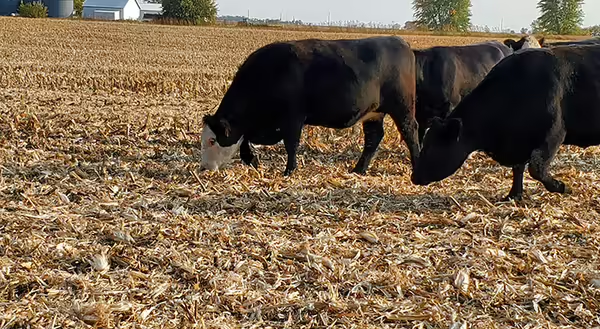
Grazing cornstalks is arguably the best cost-saving strategy Midwestern cattlemen can deploy. The cost of grazing cornstalks is low; first because the cows graze and harvest their own feed and second, because all costs to produce the plant for grain production are attributed to the row-crop operation. Even with the cost of a temporary fence (which many farmers already have) and water, grazing cornstalks is more economical than feeding hay.
Here are some frequently asked questions pertaining to grazing cornstalks.
Q: How long can I graze cornstalks?
A: This depends on stocking rate and available dry matter to graze. Using an equation developed at the University of Nebraska, a field that averages 170 bushels per acre yields 2,430 pounds of leaf and husk. Only 50 percent of the 2,430 pounds is available for the animal; the rest is trampled or lost in weathering. Thus, 1,215 pounds of DM husk and leaf per acre are available as feed.
A 1400-pound cow consumes 1,050 pounds of DM per month. At 170 bushels an acre, approximately 1 acre of cornstalks are needed to feed the cow for 30 days. Feed quality and nutrition will decline as the residue breaks down, so to feed the same cow on cornstalks for 60 days, 2 to 3 acres would be needed.
I challenge producers to continuously monitor the cattle, their behavior, and the amount of husk and leaf left in the field. Once the majority of the husk is gone, the feed value is relatively poor.
Q: Are there health concern to cows grazing cornstalks?
A: Producers should scout fields for ear drop or down corn areas. A significant amount of grain loss in fields can cause acidosis or founder in animals. Fields with these areas will need careful management via strip grazing or completely fencing the problem areas out.
Q: How much should I pay to rent cornstalks?
A: Like all rental agreements, there are several determining factors for value. The main thing is to have some kind of agreement in writing. As for price, I would suggest starting at $0.25/hd/day for a fall grazing season with gestating cows. Factors like fence, water, length of grazing season, trucking, stocking rate, and weather challenges can all influence price.
Q: Is compaction a problem?
A: Generally, not an issue. High traffic areas around water or feeder will be more susceptible to compaction. If cows are left on cornstalks into the late winter or early spring, there is a higher risk of compaction.
Q: Do I need to supplement with additional feed or protein tubs?
A: Cattle will eat the more digestible and higher protein portions first. Therefore, a good mineral is probably the only supplementation needed for the first month unless the herd includes fall-calving cows or stocker calves. For them, a supplement will be necessary to meet nutrient demands of lactation and growth, respectively. Even dry cows may need supplementation for meeting energy and protein demands after 30 days of grazing.
Q: I have a field I can’t graze. Is it worth it to bale cornstalks and feed them?
A: If you do not have the capability to graze cornstalks, they can be baled. Baling cornstalks will add costs to the feed in the form of fuel, labor, equipment costs, and fertilizer replacement costs. Even with these costs, it can still be an economical feed. Hauling manure back to the harvested fields will displace some fertilizer costs associated with cornstalk removal.
Fertilizer value is at times hard to determine for residue removal. Generally, fertilizer value of a 1200-pound round bale of cornstalks is around $15. Remember harvesting costs such as fuel, labor, transportation, and equipment wear are all real costs to evaluate.
Q: Will grazing cornstalks hurt my yield next year?
A: Researchers at the University of Illinois conducted a 3 year study at the Dudley Smith research farm, near Pana, IL. The study looked at yields in a continuous corn rotation. The study showed no statistical difference in yield following cornstalk grazing. The authors did note lower yields on yield maps in high traffic areas around waterers and mineral feeders. These lower yielding spots were still not enough to cause a difference in the treatments.
A 10-year study conducted by Nebraska researchers that showed soybeans planted after grazing cornstalks yielded 3 bushel more than those harvested in non-grazed fields. Overall, allowing cattle to harvest and trample a portion of the residue has limited impact on subsequent crop yield.